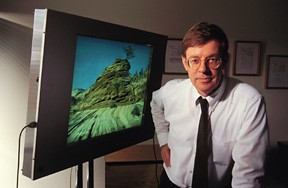Philips invests in development of Cornell invention of flat-screen television and video displays
By David Brand
A three-year-old company, Rainbow Displays Inc. (RDI), created to develop color flat-screen television and video technology invented at Cornell, has signed a joint development agreement with a unit of Royal Philips Electronics of the Netherlands, one of the world's largest consumer electronics companies.
As part of the agreement, Philips, through its Flat Display Systems subsidiary in San Jose, Calif., will invest a minority stake in RDI. The Philips subsidiary is among the world's largest suppliers of active matrix liquid crystal displays (AMLCD), or flat-panel video and television screens.
The company was set up with the aid of Cornell Research Foundation (CRF), which licensed the patents for Cornell-developed technology exclusively to the new company. In lieu of a fee for the technology, CRF took founders' stock and future royalties. Since its founding, RDI has filed 26 additional patents, several of which have been granted.
Based in Endicott, N.Y., RDI was founded in 1996 by two Cornell faculty members and two IBM executives with the mission of becoming a key supplier of large, flat-panel displays for use in business and consumer markets. The founders from Cornell are Peter Krusius, professor of electrical engineering, and Che-Yu Li, F.N. Bard Professor of Materials Science and Engineering. Li currently is the company's chairman and Krusius a technical consultant. Both have served as directors. The IBM founders are Kailash Joshi, who earned his Ph.D at Cornell, and Donald Seraphim, an IBM fellow who worked with the Cornell Electronic Packaging Program, currently directed by Krusius.
Since CRF began helping to exploit Cornell-developed inventions about 12 years ago, it has helped launch several dozen companies. However, RDI is believed to be only the second spin-off to receive an investment from a multinational leader in its field. Last year, a Cornell spin-off received an investment from a major semiconductor manufacturer. Part of the royalties and other fees received by the Cornell foundation are distributed on campus to help inventors further their research.
RDI has developed technology that allows the tiling of multiple color display units into a single, large area display with invisible seams. The technology relies on color and brightness matching that is based on ideas principally developed by Krusius. RDI has developed a 38.6-inch diagonal color AMLCD prototype capable of full-motion video with a high resolution of 800x600 pixels, or picture units. The largest AMLCDs available on the market are 19 inches to 21 inches in diagonal size
Large flat-panel displays are considered ideal for high-definition television (HDTV) and for use in airports, conference rooms and financial trading rooms, as well as for signage and work stations. Currently, AMCLDs are used on notebook-size computers, with 9.5 inches to 14.1 inches diagonal size. The Cornell spin-off is the only company with the technology to make such displays 40 inches or larger.
RDI is developing displays in other formats and resolutions for HDTV jointly with Philips under this agreement. This research is being driven by the need to replace all older consumer television sets in use in the world with digital and/or HDTV sets in the next 5-10 years, as well as by the increasing demand for multi-media uses of the new screens. Older television sets use the 100-year-old technology of the cathode ray tube, which is unable to meet the 16:9 width-to-height aspect ratios required by HDTV, and which is virtually impossible to manufacture at sizes larger than 40 inches diagonally.
Media Contact
Get Cornell news delivered right to your inbox.
Subscribe